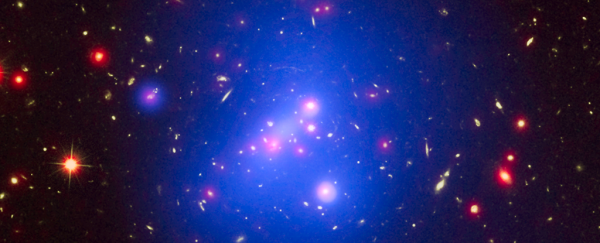The largest galaxy cluster that existed in the early portion of the Universe's history has been analysed by astronomers, and they've estimated that it weighs as much as 500 trillion Suns.
The galaxy cluster - officially dubbed IDCS J1426.5+3508, or IDCS 1426 for short - is located some 10 billion light-years away from Earth. It's so distant, in fact, that scientists say the light we can detect from it dates back to when the Universe was only a quarter of its current age.
"Of all the structures we've ever seen, this is the most massive in the first 4 billion years of the Universe," astronomer Mark Brodwin of the University of Missouri-Kansas City, told media at the annual meeting of the American Astronomical Society.
Galaxy clusters like IDCS 1426 are the largest objects in the Universe that are bound together by gravity, formed from hundreds or thousands of individual galaxies.
IDCS 1426 was first discovered in 2012 using NASA's Spitzer Space Telescope, and astronomers have since studied it with the space agency's Hubble Space Telescope and Keck Observatory. Now Brodwin's team has used the Chandra X-ray Observatory to find out more about the cluster.
According to the researchers, the distance of IDCS 1426 means we're seeing the cluster in its early youth, when the Universe was just 3.8 billion years old. That might sound pretty old to you and me, but with conventional theory pegging the Universe as about 14 billion years old, it's still a long, long time ago.
The new data reveal that about 90 percent of the mass of IDCS 1426 is dark matter, a substance we know little about because we can only detect its existence through its gravitational pull on ordinary matter.
"We are really pushing the boundaries with this discovery," said Brodwin in a press release. "As one of the earliest massive structures to form in the Universe, this cluster sets a high bar for theories that attempt to explain how clusters and galaxies evolve."
Chandra reveals that a bright knot of X-rays is located near the middle of ICDS 1426. The astronomers believe this overdense and surprisingly cool core has been dislodged from the very centre of the cluster, perhaps due to a merger with another developing cluster 500 million years previously. They say this merger would be causing the core to be sloshing around within ICDS 1426 like wine in a tipped glass.
"Mergers with other groups and clusters of galaxies should have been more common so early in the history of the Universe," said one of the team, Michael McDonald from the Massachusetts Institute of Technology. "That appears to have played an important part in this young cluster's rapid formation."
Aside from the comparatively cooler core, other parts of the cluster contain extremely hot gas, leading the researchers to think IDCS 1426 formed very rapidly. With signs that the amount of elements heavier than hydrogen and helium is unusually low, the astronomers believe the young galaxy cluster may still be in the process of enriching its hot gas with these elements.
While IDCS 1426 is not as large at the massive 'El Gordo' galaxy cluster NASA discovered in 2014, the astronomers say with time it could have the potential to grow into something equally huge.
"Statistically speaking, it is a progenitor of 'El Gordo'," Brodwin told the American Astronomical Society.
The researchers findings are available online at arXiv.org and will be published in The Astrophysical Journal.
